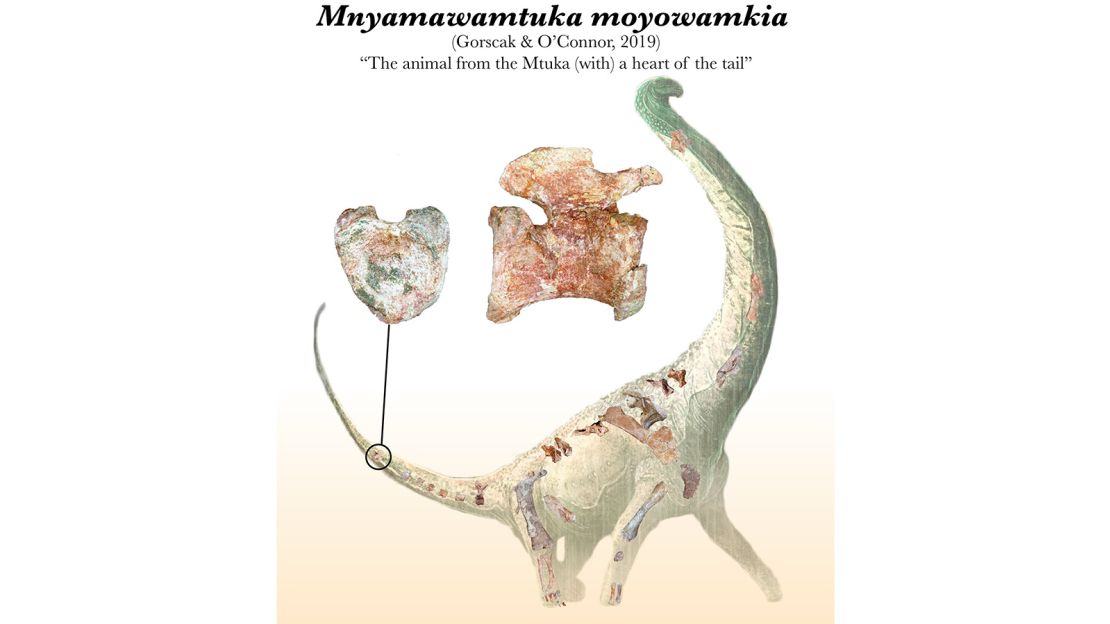Just in time for Valentine’s Day, researchers have announced thediscovery of a recently unknown dinosaur fossil hiding a heart-shaped surprise in its tail. The study detailing the fossil was published in the journal PLOS ONE on Wednesday.
The new species has been named Mnyamawamtuka moyowamkia. In Swahili, this means “animal of the Mtuka with a heart-shaped tail.”
This particular titanosaur lived about 100 million years ago during the middle Cretaceous period in Tanzania, and it’s the only one of its kind that’s been found. The large, long-necked dinosaur belonged to the sauropod group, known as the largest land animals on Earth. During the Late Cretaceous period, when the other sauropods had disappeared, the titanosaurs flourished and diversified.
But a lack of well-preserved fossils has caused questions over their evolution, especially early on, and few of their fossils have been found outside South America.
The researchers, funded by the US National Science Foundation, were suspended by ropes to excavate the fossil from a cliff wall in the quarry by the Mtuka River in southwest Tanzania. These exposed rocks represent the western branch of the great East African Rift System. It has been home to many fossil discoveries because it allowed fossils to remain well-preserved.

Mechanical excavators also helped remove the giant fossil. If it hadn’t been found and excavated, the skeleton may have eroded during one of the intense wet seasons, said Patrick O’Connor, study author and professor of anatomy at Ohio University, in a statement.
The fossil is one of the more complete titanosaurs recovered in Africa, and it includes teeth, ribs, vertebrae and limb bones. The centrum of its tail vertebrae is oddly heart-shaped, which contributed to its name.
This titanosaur is similar to the Late Cretaceous titanosaur Lithostrotia species, which means this was the missing early stage of evolution that led to titanosaur diversity. This fossil from southern Africa is also similar to fossils found in South America.

“Although titanosaurs became one of the most successful dinosaur groups before the infamous mass extinction capping the Age of Dinosaurs, their early evolutionary history remains obscure, and Mnyamawamtuka helps tell those beginnings, especially for their African side of the story,” Eric Gorscak, lead study author and research associate at the Field Museum of Natural History, said in a statement.
“The wealth of information from the skeleton indicates it was distantly related to other known African titanosaurs, except for some interesting similarities with another dinosaur, Malawisaurus, from just across the Tanzania-Malawi border,” he said.
The team has found other Tanzanian titanosaurs, as well as early crocodile relatives, clues about early monkey and ape evolution and even the oldest evidence for insect farming. All of them provide insight into the evolution of life and the ecosystem at the time in Africa.
And of course, it’s timely to announce the discovery around Valentine’s Day.
“This new dinosaur gives us important information about African fauna during a time of evolutionary change,” said Judy Skog, program director in the National Science Foundation’s Division of Earth Sciences, in a statement. “The discovery offers insights into paleogeography during the Cretaceous. It’s also timely information about an animal with heart-shaped tail bones during this week of Valentine’s Day.”
The researchers have many more mysteries they want to address.
“The Tanzanian story is far from over but we know enough to start asking what paleontological and geological similarities and dissimilarities there are with nearby rock units. Revisiting Malawi is my top priority to address these broader, regional questions,” Gorscak said. “With Mnyamawamtuka and other discoveries, I’m not sure to view it as writing or reading the next chapters in the paleontological book of Africa. I’m just excited to see where this story is going to take us.”






































































































































































